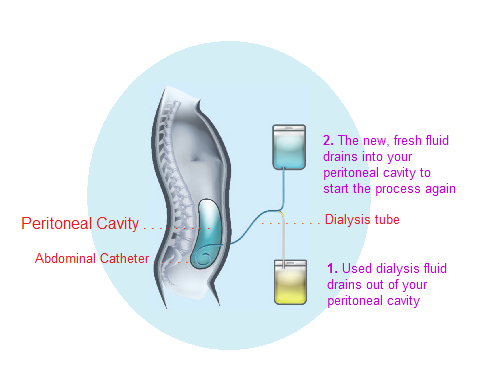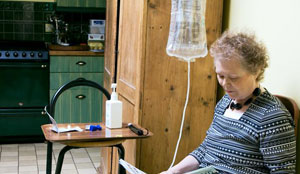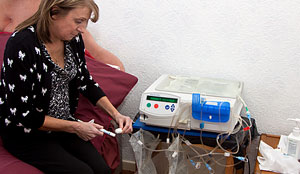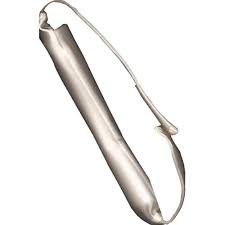Peritoneal Dialysis
What is peritoneal dialysis?
This is a form of dialysis that the hospital will teach you to do yourself at home. The peritoneum is a natural membrane lining your abdomen and surrounding most of your organs. It has a very good blood supply and can be used as a filter.
To have PD, a small, soft, plastic tube (called a catheter) is inserted into your abdomen. This allows dialysis fluid to be drained in and out of the peritoneal cavity. The peritoneum holds the dialysis fluid within your abdomen. This is usually between one and a half and two and a half litres (about two and a half to four and a half pints). The amount depends on your size and how much dialysis you need.
Waste products are passed from your blood, across your peritoneal membrane, and absorbed into the dialysis fluid. When the fluid is drained out again it takes waste and extra fluid out of your body.
Dialysis is happening all the time because there is fluid in your abdomen until the next ‘exchange’. The fluid needs to be changed regularly. This can be done either by hand four times a day (known as CAPD) or by a machine overnight (known as APD).

© courtesy of Guy’s and St Thomas’ NHS Foundation Trust.
Is any surgery involved?
Yes, you will need a small operation to put the catheter into your abdomen. Many people stay in hospital overnight, but you might be able to go home the same day.

© renal fellow network
Are there different types of PD?
There are two types of PD: Continuous Ambulatory Peritoneal Dialysis (CAPD) and Automated Peritoneal Dialysis (APD).
CAPD – involves exchanging fluid four times a day.

© NHS Choices
Continuous – means you are dialysing all the time.
Ambulatory – between exchanges of dialysis fluid you can carry out your everyday activities.
Peritoneal – using the peritoneal cavity.
Dialysis – the process by which waste products and fluid are removed from your body.
APD – involves exchanging fluid during the night.

© NHS Choices
Automated – a machine performs the exchanges overnight while you sleep.
Peritoneal – using the peritoneal cavity.
Dialysis – the process by which waste products and fluid are removed from your body.
Can I have help with PD?
Most people find PD easier to learn than they expected, and soon become confident performing their exchanges independently. However, if you are physically unable to perform the whole procedure yourself, or need extra support while learning, you may be able to receive assistance. Having assisted APD means you must be able to connect your catheter to the PD machine yourself, but preparing the machine and disposing of used equipment is done by a healthcare assistant who visits you at home every day.
How long does it take?
CAPD takes about 20-30 minutes to drain the fluid out and in. You need to do this four times every day. You also need time for setting up before dialysis and for clearing away afterwards. APD takes about 30 minutes to set up the machine before you go to bed. You will also need about 30 minutes the next day to clean the machine and tidy up. You will be attached to the machine for about eight hours every night. Learning how to do PD takes as long as you need. This is usually about five days. It can be done:
- at the hospital
- in your own home
- at a training centre.
- Does PD hurt?
It might seem uncomfortable at first as you get used to having fluid in your peritoneal cavity. The fluid is warmed to body temperature so you should not feel it going into your body.
Is the APD machine noisy?
You might be aware of a quiet hum when it is working. The alarm on the machine will go off if you are lying on your catheter, stopping the fluid from draining out. The machine can be stopped temporarily for visits to the bathroom or sex.
Can I go swimming?
Yes, swimming is a good form of exercise. However, we advise that you swim in a chlorinated pool as the sea and rivers can be contaminated, which means there is a risk of you getting an infection. We can give you a special pouch to put over the catheter to prevent it from getting wet.
Can I have a bath?
To reduce the risk of infection, we advise you to shower rather than bath once you start PD. If you do not have a shower, you can use a shower attachment on your bath taps.
How do I keep my catheter from pulling?
A loose hanging catheter can be uncomfortable, unhygienic and potentially be pulled causing injury or damage to the catheter. There are a number of solutions available depending on your individual circumstances, but the one used by most patients at St George’s is the catheter belt. See the picture below – click for links to the manufacturers website – they will ship to the UK.
Other manufacturers can be found by using an internet search engine and typing “PD catheter belts”.
Why PD may be right for you
- You do not have to come into hospital to do your dialysis. You will only need to come to the clinic for check ups.
- You should be able to fit dialysis in around family, social and work life.
- It is similar to the way your kidneys work because it is happening all the time. This means that what you eat and drink is not as restricted as with haemodialysis.
- Supplies can be delivered to most places.
- It is fine to exercise while on PD. However, we advise against any heavy lifting or contact sports.
- If you choose APD you dialyse overnight instead of during the day, making it easier to fit around work and leisure.
Why PD may not be right for you
PD needs to be done every day. You need to be able to build this into your life.
You will need a clean, dry area to store supplies, which take up about the same space as a single bed. This could be a spare room, a large cupboard, a shed or a garage.
PD may not be suitable for you if you:
- have had major surgery on your abdomen.
- have bowel disease such as diverticulitis, colitis or are very overweight.
- live alone and need significant support.
- do not have a permanent address.
If you choose CAPD you will need to be flexible in your daytime activities so that you have time to do four exchanges.
What are the possible complications with PD?
The main complication is peritonitis, which is an infection of the peritoneal membrane, the lining of the peritoneal cavity where the fluid sits. You will be shown how to reduce the risk of peritonitis and what to do if you think you have it.
Occasionally you might get an infection where the catheter comes out of your abdomen, known as the exit site. This can usually be treated successfully with antibiotics.
Sometimes people have problems draining the fluid out of their body, but you can be taught how to deal with this.
In a small number of cases an abdominal hernia might happen because of pressure caused by the dialysis fluid. If this happens you will need a small operation to repair the hernia.
More information about Peritoneal Dialysis (PD)
More information can be found on the following sites:
http://www.kidneypatientguide.org.uk/pd.php
http://www.kidney.org.uk/help/medical-information-from-the-nkf-/medical-info-pd/
And you can download the following brochure on PD.






